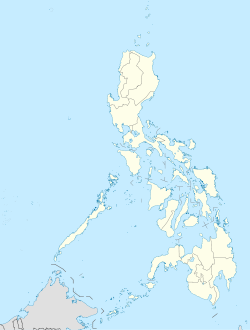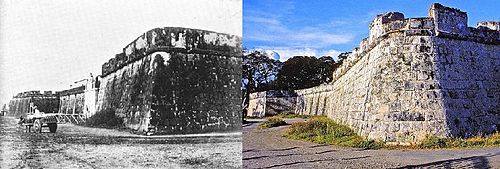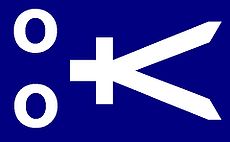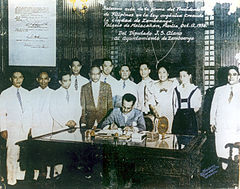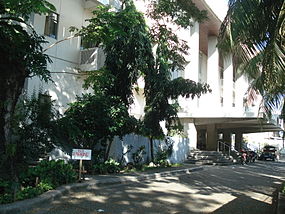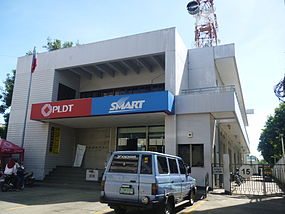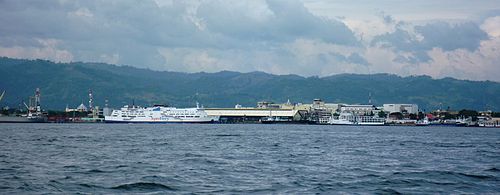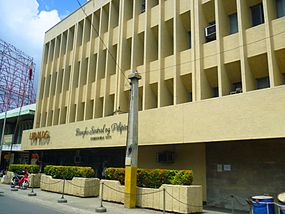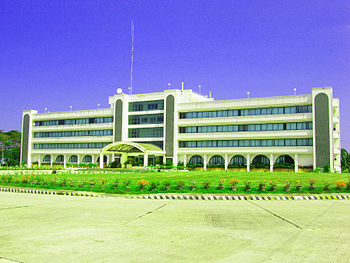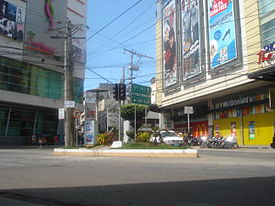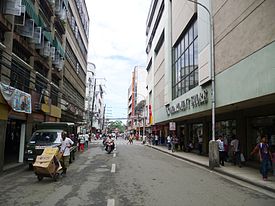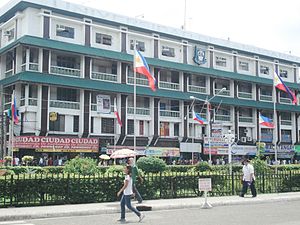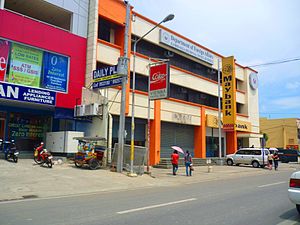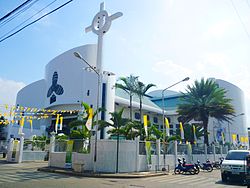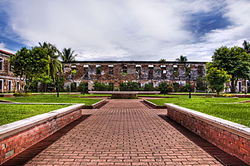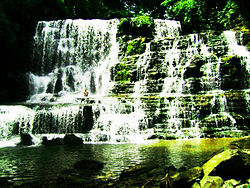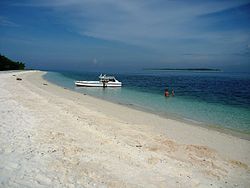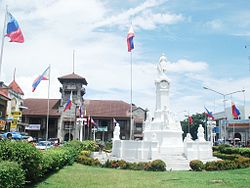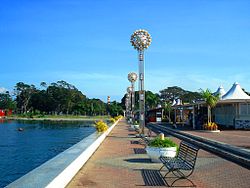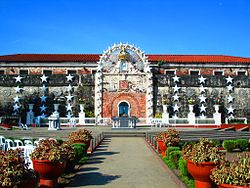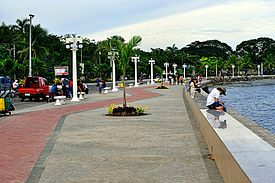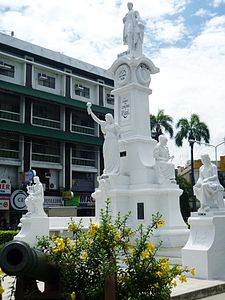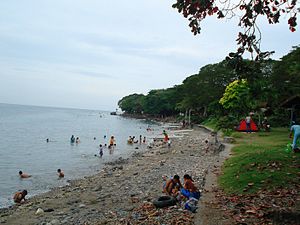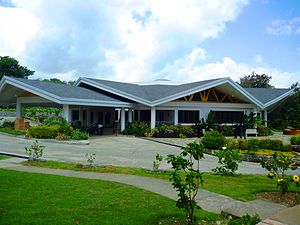- Zamboanga City
-
City of Zamboanga
Ciudad de Zamboanga— Chartered, Independent and Highly Urbanized City — 
Coat of armsNickname(s): El Orgullo de Mindanao -The Pride of Mindanao, Ciudad de Flores - City of Flowers, Zamboanga Hermosa - Beautiful Zamboanga, Ciudad Latina de Asia - Asia's Latin City, Philippines' Little Spain, Sardines Capital of the Philippines Motto: "Adelante Zamboanga" Chavacano
"Onward, Zamboanga"Coordinates: 6°52′N 122°4′E / 6.867°N 122.067°E Country  Philippines
PhilippinesRegion Region IX Founded XIV Century Regional Centre [1] Region IX
(Western Mindanao)Official language(s) Zamboangueño Chavacano,
Filipino (based on Tagalog)
EnglishGovernment – Type Mayor-council – Mayor Celso Lobregat (LDP) (re-elect) – Vice Mayor Cesar Iturralde (LDP) – Representatives – City Council CouncilorsArea – Land 1,483.3849 km2 (572.7 sq mi) Elevation 16.0 m (52 ft) Population (2010 Estimated) – Total 947,020 – Rank Sixth Demonym Zamboangueño (m) Zamboangueña (f) Time zone PST (UTC+8) Postal code 7000 Area code(s) 63 (Philippines)
+ 62 (Zamboanga)Patron Saints Our Lady of the Pillar
St. Pius XWebsite Official government website of the City of Zamboanga Timeline History of Zamboanga City[2] Year Event
- 1200 Ciudad de Zamboanga formally named "Jambangan" is founded.
- 1300 The Malayan settlers influx.
- 1400 Mohammedanism was introduced to these people of Malayan descent.
- 1513 Don Juan Ponce de Leon named the land for Spain and named it "La Florida".
- 1575 The newly appointed Filipinas Island Governor and Captain-General Doctor Francisco de Sande.
- 1575 Gov. Sande possible first Spanish encounter of "Jambangan" or "La Florida" place and people.
- 1593 Catholic mission was established in the La Caldera area.
- 1596 La Caldera Presidio is built and garrisoned under the rule of Capt. Don Juan Ronquillo del Castillo.
- 1598 La Caldera Presidio and Mission is abandoned, signifying weakness of the Spaniards, and causes rise of Moro offensive.
- 1635 Captain Juan de Chaves landed at Jambangan.
- 1635 Fuerza de San José was laid by Father Melchor de Vera.
- 1635 Dia de Los Chavacanos de Zamboanga.
- 1646 Fuerza de San José was attacked by the Dutch.
- 1666 Fuerza de San José was reconstructed by the Jesuits.
- 1718 Fuerza de San José was renamed Real Fuerza de Nuestra Señora La Virgen del Pilar de Zaragosa.
- 1719 Rebuild under the Management of Juan Sicarra.
- 1784 La Caldera Fort was re-built by the Spaniards.
- 1899 Fort Pilar and its Spanish troops, in Southern Philippines, surrendered to the Revolutionary Government of Zamboanga.
- 1899 The first Republic of Zamboanga in the Island of Philippines with Zamboangueño Chavacano as it's Official Language.
- 1899 General Vicente Alvarez was elected as the first President of Zamboanga
- 1899 Fort Pilar was occupied by the Americans under Gen. J.C. Bates.
- 1901 Inauguration of Municipalidad de Zamboanga under Public Act No. 135.
- 1903 Zamboanga was desginated as the capital of the Moro Province and Zamboanga Province.
- 1905 Construction of Ayuntamiento de Zamboanga under the Federal Government of United States of America.
- 1910 Pope Pius X created the Diocese of Zamboanga and gave it jurisdiction over the whole island of Mindanao.
- 1912 Christopher Frederick Bader was appointed as the first American Mayor of Ciudad de Zamboanga under the American Occupation.
- 1935 Zamboanga was the largest city in the world area-wise with the island of Basilan included in the city.
- 1936 Zamboanga was the first locality of the vast Moro Province to be honored with a chartered city status.
- 1937 Nicasio S. Valderrosa became the first mayor of Zamboanga City under Commonwealth Act No. 39.
- 1942 Fort Pilar seized by the Japanese Imperial Army.
- 1945 The combined Filipino and U.S. troops liberated Zamboanga City and defeated the Japanese.
- 1946 The Americans transferred the jurisdiction of Fort Pilar to the custody of the newly independent Republic of the Philippines.
- 1948 Zamboanga City lost the status of being the biggest city in area in the world when the island of Basilan was given independence and was converted into a province.
- 1952 The Province of Zamboanga was divided into two separate sub-ruling provinces.
- 1955 Roseller Tarroza Lim was elected to the Philippine Senate making him the first Zamboangueño Philippine Senator.
- 1958 Pope Pius XII elevated the diocese of Zamboanga into an Archdiocese.
- 1983 Zamboanga was declared a highly urbanized city in the Philippines.
- 1984 Mayor Cesar Cortez Climaco was assassinated by an unknown assassin in November.
- 1995 The Zamboanga City Special Economic Zone Authority was established by virtue of Republic Act 7903 authored by Congresswoman Maria Clara L. Lobregat and signed by President Fidel V. Ramos.
- 1998 Ground Breaking of Modern Metropolitan Cathedral of the Immaculate Conception in Asia
- 2004 The City's Lone District was divided into two districts by virtue of Republic Act No. 9269 proposed by Congressman Celso Lobregat and signed by President Gloria Macapagal-Arroyo.
- 2006 Philippines’ Southern Gateway known as Asia’s Latin City .[3]
- 2008 The Supreme Court of the Philippines declare Memorandum of Agreement on Ancestral Domain (MOA-AD) as "Null and Void".
- 2010 Hon. Beng Climaco y Salazar was elected as House Deputy Speaker for Mindanao and House Committee on Women.[4]
- 2011 Former and presently Ciudad de Zamboanga is the Regional Centre of Region IX
The City of Zamboanga (Zamboangueño Chavacano/Spanish: Ciudad de Zamboanga): is a highly urbanized, independent and a chartered city located in Mindanao, Philippines. It is currently ranked as the 6th most populous city (947,020 estimated population as of 2010) and the 3rd largest by land area in the Philippines (1,483.3849/km2 (572.738/sq mi)).[5][6] It is located at the southernmost tip of the Zamboanga Peninsula and is bounded in the north by the provinces of Zamboanga Sibugay and Zamboanga del Norte, in the west by the Sulu Sea, in the east by Sibuguey Bay, and in the south by the Basilan Strait. It is approximately 460 nautical miles (850 km) south of City of Manila, 365 nautical miles (676 km) northeast of Kota Kinabalu, Malaysia, 345 nautical miles (639 km) northeast of Manado, Indonesia, bounded to the west by Sulu Sea, on the east by the Moro Gulf, and on the south by the Basilan Strait and Celebes Sea. Its distance from Cebu City is about 372.57 nautical miles (690.00 km), and is 340.17 nautical miles (629.99 km) from Davao City.[7]
The Ciudad de Zamboanga’s climates are generally of the third and fourth types where it is practically from June to December. The highest rainfall occurs on the month of July while the lowest rainfalls on the month of April. The city is outside the typhoon belt, hence, typhoons rarely visit the Ciudad de Zamboanga.
It is now the centre of economic activities in Mindanao with its modern international seaport, which is one of the principal ports of call for inter-island and international shipping. Its airport, which also classified as an international airport, provides air transportation to various domestic destinations. Both seaport and airport serve as transshipment points of various goods to neighboring cities and countries.
It is the seat of one of the largest number of military and police bases in the country. It is also home of the 3rd Air Division of the Edwin Andrews Air Base, which handles the Air Force of the Philippines in the city; and the 6th Naval District in Camp General Basilio Navarro also known as Western Mindanao Command, the main headquarters of Armed Forces of the Philippines in Western part of Mindanao; the Philippine Army, Philippine Marines, and Philippine Navy are assigned to that command. The "Camp Enrile" and other three military camps can be found in the city.
It is the former capital of Moro Province now Mindanao Island (1903 to 1913) in the Philippines. On September 15, 1911, the Municipalidad de Zamboanga was converted into a Ciudad by the legislative order Act. No.272.[8] It is known as CIUDAD LATINA DE ASIA in Zamboangueño Language or in English Language Asia's Latin City for its strong Hispanic/Latin influence.
Currently, Ciudad de Zamboanga is one of the primary hubs in the Philippines, being the premier city in Zamboanga Peninsula Region in terms of commerce, trade, health services, financial institutions and education.[9][10]
Ciudad de Zamboanga serves as an entry point in the Philippines to many destinations in Southeast Asia.
Contents
History
Ciudad de Zamboanga was founded in the late 12th or early 13th century, with the earliest people living there being the Subanen, an indigenous tribe of Malay origin. The Subanen people's name for Zamboanga, 'Sung Lupa', means 'Pointed Land'. Speculation that the name of zamboanga comes from the word 'Jambangan', meaning the 'Land of Flowers', is met by others insisting the name derives from the word 'Saguan' or 'Sambuan', A Malay word for the paddle used by natives to paddle the vintas in the sea. Still another possible origin is 'Sambon' which refers to herbal plants that grew abundantly in the city.[11] Badjao, Samal, Tausug and the Yakan tribes from Malayan descent settled in the same part of Mindanao in the early 14th century.[12] Mohammedanism and Islam gained predominance in the 15th century in the Philippines first as a non-indigenous religion from these Malay peoples after Jews and Christians arrived.[13]
Spanish rule
The Spaniards arrived in the country in the year 1520, as the first European invaders in the country.[14] In the year 1569 Zamboanga was chosen as the site of the Spanish settlement and garrison on La Caldera (now called Barrio Recodo).[15] The goal was to use it for the reinforcement of their troops in the country, making way for Christian settlements by converting the people and protecting the island against foreign invaders and Moro pirates. After 3 decades (1599), the fort was closed and transferred to Cebu due to great concerns about attack by the English on that island, which did not occur. After having abandoned the city, the Spaniards joined forces with Visayan troops and reached the shore of Ciudad de Zamboanga to bring peace to the island against Moro pirates.[16]
Ciudad de Zamboanga became the main headquarters of the Spaniards in 1634 upon approval of King Philip IV of Spain.[16] Thousands of Spanish troops headed by a Governor General from Spain took the approval to build the first Zamboanga fortress (now called Fort Pilar) in Ciudad de Zamboanga to forestall enemies in Mindanao like Moro pirates and other foreign invaders.[17] The Zamboanga fortress became the main focus of a number of battles between Moros, Chinese and Spaniards while the Spanish ruled the region from 16th to 18th centuries. While the region was already dominated by Catholicism, Muslims kept up a protracted struggle against the ruling Spaniards in the country into the 18th century.[18][19]
In the Year 1831, the Custom house in Ciudad de Zamboanga was established as a port, and it became the main port for direct communication, trading some goods and other services to most of Europe, Southeast Asia and Latin America.[20] The Americans arrived in the Philippines, headed by General Weyler with thousands of troops to defeat the Spaniards who ruled it more than three centuries. The Spanish Government sent more than 80,000 Spanish troops in the Philippines. The Spanish Government completely and peacefully surrendered the islands to the United States in the 1890s.[21]
American and Japanese period
Before the end of the 19th century; The Republic of Zamboanga was established during the American period in the Philippines and it briefly existed from May 18, 1899 to March 1903. The first President of the Republic of Zamboanga was General Vicente Alvarez and succeeded by Isidoro Midel and Mariano Arquiza.[22]
During the American colonial period. Ciudad de Zamboanga hosted a number of American regional governors, including General John J. Pershing, who was military commander/governor of the Moro Province from 1909 to 1914. Gen. "Black Jack" Pershing became the Supreme Commander of the American Expeditionary Force in Europe during World War I when the US entered the war in 1917. The entire Moro Province of Mindanao was administered directly from the city, effectively making the Zamboanga Mindanao's first and only Capital City. Soon after the establishment of the Commonwealth, it was the center of commerce, trade, and government of Mindanao Island, being the capital of the Moro Province.[23]
Ciudad de Zamboanga became a chartered city in the year 1936.[24] In Pre-World War II, Pettit Barracks, a part of the US Army's 43d Infantry Regiment (PS), was stationed. When the Japanese invaded the Philippines, they were headed by Vice Admiral Skugiyama Rokuzo and accompanied with Rear Admiral Naosaburo Irifune and landed at Zamboanga on March 2, 1942.[25] They established a defense headquarters in the city while ruling the government in more than two years. The Japanese government in the city was eventually overtaken by American and the Filipino forces in 1945.[22]
Moro ProvinceMoro Province Former division of the Philippines ← 
←
←
1903-1914  →
→Flag
Location of the historical Moro Province. Capital Ciudad de Zamboanga Historical era American Occupation - Established 1903 - Disestablished 1914 Today part of Cotabato, Sulu, Zamboanga del Norte, Zamboanga del Sur, Zamboanga Sibugay, Zamboanga City, South Cotabato, Davao del Norte, Davao del Sur, Davao Oriental, Maguindanao, Saranggani, Lanao del Norte, Lanao del Sur and Davao. Martial law
In 1953, Cesar Climaco was elected Mayor. He was a flamboyant personality who pursued policies of good governance and cleanliness.[26] On the 1961 Philippine General Election, Cesar Climaco was unsuccessful to run for the Senate under the Liberal Party, but he was appointed as Customs Commissioner under the Macapagal Administration,[27] and later a prominent critic of Ferdinand Marcos. He was reelected as a mayor in Zamboanga city again in 1980, at a time when martial law was declared in the city because of growing violence. Cesar Climaco was assassinated on November 14, 1984.[28]
Philippines after Marcos
After the Marcos regime, Zamboanga city was still enjoying its good economic activities, but the growth was not rapidly high due to incompetent leaders that ruled the city after martial law. At present, Ciudad de Zamboanga is the main hub in Zamboanga Peninsula through education, financial institutions, health and services, infrastructural projects and a center of foreign investment through BIMP-EAGA in relation with other major cities in Southeast Asia.[29]
Geography
Location
See also: List of Islands in Zamboanga City and List of Barrios in Zamboanga CityThe Ciudad de Zamboanga's physical characteristics have the following advantages: (i) it has an even distribution of rainfall; (ii) it has no liquefaction prone area; (iii) it is outside the typhoon belt; and (iv) it is outside of major fault lines/no active volcano.[30]
The main land territory of Ciudad de Zamboanga, which encompasses 1,681 kilometers ( 645 square mile ), there are (officially) 11 islands that are part of its principality. The most popular of these islands is the Great Santa Cruz Island, It's tantalizingly beautiful scenery encompasses the rare "pink sand". almost 10– 15 minutes while riding a boat from the city to the Great Sta. Cruz Island. Under the Presidential Decree No. 654, President Ferdinand Marcos declared that the Santa Cruz Islands as National Park and Tourism Development in the City of Zamboanga. Aside from Santa Cruz island, the city has also 28 islands off the mainland coast. All of these islands come under the city's jurisdiction. The biggest of these islands is Sacol (about 12 km. long and 8 km. wide), and eleven of these islands on the Moro Gulf coast form a cluster known as the Eleven Islands, the largest being Cabugan Island (approx. 11 hectares).[31]
Geology and Geomorphology
The southwest and eastern sides of Ciudad de Zamboanga are bounded by irregular coastlines with generally rocky terrain with occasional stretches of sandy and gravely beaches. The coastal profile usually descends abruptly towards the sea. In some places where there are rivers, embayment occurs, thus, filling up areas with alluvial materials and producing small tracts of coastal plains and sometimes-broad plains.
It has been observed that younger rock formation occurs in a higher elevation. Areas along the northeastern coast, which were mostly part of the lower alluvial lowlands, and small low lying areas are characterized by the presence of cold water sediments. These are subjected to the daily inundation of tidal movement. The formation of basement complex along the boundaries of Zamboanga del Norte is influenced by the north-south trending fault while a young volcanic cone influences the formation of volcanic outcropping in the area.
Topography, Slope and Elevation
The overall topography of the city could be described as rolling to very steep. There are some flat lands, mostly narrow strips along the east coast. The urban center is mostly flat with a gentle slope to the interior, ranging from 0 to 3%. The highest registered elevation is 1,200 meters. In terms of slope, a large portion of Ciudad de Zamboanga, about 38,000 hectares, have slopes ranging from 18-30%. Another 26,000 hectares have been described as having slopes pf less than 3% while about 37% of the area or a total of 52,000 hectares have slopes ranging from 30% to more than 50%.[32]
Climate and temperature
Zamboanga features a tropical wet and dry climate under the Koppen climate classification. Zamboanga City enjoys a location that is free from the typhoon belt area.
Climate data for Zamboanga, Philippines Month Jan Feb Mar Apr May Jun Jul Aug Sep Oct Nov Dec Year Average high °C (°F) 31.9
(89.4)32.0
(89.6)32.3
(90.1)32.6
(90.7)32.4
(90.3)31.7
(89.1)31.4
(88.5)31.7
(89.1)31.8
(89.2)31.8
(89.2)31.7
(89.1)32.1
(89.8)31.95
(89.51)Daily mean °C (°F) 27.2
(81.0)27.3
(81.1)27.7
(81.9)28.0
(82.4)28.1
(82.6)27.7
(81.9)27.4
(81.3)27.5
(81.5)27.6
(81.7)27.5
(81.5)27.5
(81.5)27.4
(81.3)27.58
(81.64)Average low °C (°F) 22.4
(72.3)22.5
(72.5)23.2
(73.8)23.4
(74.1)23.9
(75.0)23.6
(74.5)23.3
(73.9)23.4
(74.1)23.3
(73.9)23.2
(73.8)23.3
(73.9)22.7
(72.9)23.18
(73.73)Precipitation mm (inches) 32.4
(1.276)45.6
(1.795)37.1
(1.461)53.3
(2.098)81.3
(3.201)125.8
(4.953)136.4
(5.37)114.0
(4.488)133.9
(5.272)157.1
(6.185)98.8
(3.89)51.0
(2.008)1,066.7
(41.996)Source: Hong Kong Observatory[33] Demographics
Historical populations Year Pop. ±% 1898 19,844 — 1903 20,692 +4.3% 1918 42,007 +103.0% 1939 73,894 +75.9% 1948 103,317 +39.8% 1960 131,489 +27.3% 1970 199,901 +52.0% 1975 265,023 +32.6% 1980 343,722 +29.7% 1990 442,345 +28.7% 1995 511,139 +15.6% 2000 601,794 +17.7% 2007 774,407 +28.7% Est.2010 947,020 +22.3% Source:[34] Population
The population of Ciudad de Zamboanga has registered an increase of 172,613 (an average annual growth rate of 3.54 percent) in seven years, latest data from the National Statistics Office (NSO) showed. The data released by the NSO regional office based in this city showed that from 601,794 in 2000, the population grew to 774,407 as of 1 August 2007.[35]
Among the 98 barangays in this Ciudad de Zamboanga, Talon-Talon was the most populous with a 3.9-percent share of this city’s population. Next to Talon-Talon were Tetuan (3.8 percent), Baliwasan (3.6 percent), Pasonanca (3.5 percent), Calarian and Tumaga both with 3.3-percent share, and San Jose Gusu (3.2 percent).
Religion
According to statistics compiled by the Philippine government, the most dominant religion in the city is Christianity with 73% of the population adhering to the faith. The majority of Christians are Roman Catholics with minorities of Protestants and Orthodox Christians. The remaining 27% percent belongs to other non-Christian faiths such us Buddhism and Islam.
Language
The Official and/or Native language of Zamboanga City is Zamboangueño Chavacano, a Philippine-Spanish Creole. Other common languages in the city are Tagalog, English and Bisaya/Cebuano. Fookien (a Chinese dialect) and Tausug are also prevalent. Approximately 64% of the city’s population consists of the native families of the old Zamboanga, who were greatly influenced by the Spanish culture and lifestyle which is now called as a pure Chavacano de Zamboanga or Zamboangueño. Whilst 36% of the city’s population is composed of cultural minority members, groups of Muslim communities, such as the Subanens, Tausugs, Yakans, Samals, and the Badjaos are dispersed around the city.[36]
Government
See also: List of Mayors of Zamboanga CityList of City MayorsYear Mayors[2] 1914 Christopher Frederick Bader 1914–1916 Victoriano Tarroza 1916–1919 Alfonso Ramos 1919–1922 Crispin Atilano 1922–1925 Gregorio E. Ledesma 1925–1934 Felipe Ramos 1934–1937 Antonio Toribio 1937–1939 Nicasio Valderrosa 1939–1940 Pablo R. Lorenzo 1940–1942 Agustin L. Álvarez 1942–1945 Japanese Occupation 1945–1946 Return of American Occupation 1945–1946 Gregorio E. Ledesma 1946–1972 Third Republic of the Philippines 1946–1947 Pantaleón A. Pelayo 1947–1949 Vicente C. Suarez 1949–1953 Manuel D. Jaldon 1953–1954 Cesar C. Climaco 1954–1955 Hector C. Suarez 1956–1961 Cesar C. Climaco 1961–1963 Tomas F. Ferrer 1964–1967 Hector C. Suarez 1967–1972 Joaquin F. Enriquez, Jr. 1972–1981 Martial Law Years 1972–1975 Joaquin F. Enriquez, Jr. 1975–1980 Jose Vicente F. Atilano II 1980–1981 Cesar C. Climaco 1981–1986 Fourth Republic of the Philippines 1981–1984 Cesar C. Climaco 1984–1986 Manuel A. Dalipe 1986–present Fifth Republic of the Philippines 1986–1987 Rustico M. Varela 1987 OIC Julio Cesar F. Climaco 1988–1998 Vitaliano D. Agan 1998–2004 Maria Clara Lobregat 2004 Acting- Erico Basilio Fabian 2004–present Celso L. Lobregat Ciudad de Zamboanga is the third oldest city in the Philippines, with a strong mayor-council form of government.[37] The city received its own representation for the Philippine Congress since 1984. The former lone congressional district was divided into two separate districts: the West Coast District from the City Proper to Limpapa represented by incumbent Congresswoman Beng Climaco, while in the East Coast District from Tetuan to Licomo is headed by incumbent Congressman Erico Basilio A. Fabian. The government is composed of a Mayor, Vice Mayor, two district representatives, and eight councilors in each district.[38]
Congresswoman Beng Climaco of District I was elected House Deputy Speaker for Mindanao and Women of the 15th Congress of the Philippines, a very important position that is considered to be the first for a representative from Zamboanga City.[39]
The House Committee on Justice recently approved through an omnibus motion, pertinent house bills creating new Regional Trial Courts (RTCs) in various provinces and cities, among which a proposal to create a total of 19 additional RTC branches for Zamboanga del Sur and the cities of Pagadian and Zamboanga authored by Deputy Speaker for Mindanao Climaco.
House Bill 1455 entitled an “An Act Amending Sections 14 (J) and 29 of Batas Pambansa Blg. 129, Otherwise Known as The Judiciary Reorganization Act of 1980”, principally authored by Cong. Climaco calls for the creation of four (4) additional Regional Trial Court branches in the Province of Zamboanga del Sur, and the Cities of Pagadian and Zamboanga with an overall total of nineteen (19) branches.[40]
Out of the 19 branches, ten (10) seats shall be for Zamboanga City, and the remaining seats for Pagadian City, Molave, San Miguel, Ipil, and Aurora.
The city of Zamboanga is composed of more than 774,407 people since 2007.[41] Under the Republic Act No. 9269, Zamboanga City is qualified to have a third district representative in the House of Representatives of Congress.[42]
Armed forces and law enforcement
In the Philippines, Ciudad de Zamboanga hosts one of the largest number of military and police bases in the country. The Edwin Andrews Air Base, which handles the Air Force of the Philippines in the city located in the Zamboanga International Airport; Camp General Basilio Navarro also known as Western Mindanao Command, the main headquarters of Armed Forces of the Philippines in Western part of Mindanao; the Philippine Army, Philippine Marines, and Philippine Navy are assigned to that command. The "Camp Enrile" and other three military camps can be found in the city.
Lieutenant General Raymundo Ferrer is the currently assigned Chief of Staff of the Western Mindanao Command. He is the officer-in-charge of the 1st Scout Ranger Regiment, 1st Infantry (TABAK) Division, Light Reaction Battalion, Naval Forces Western Mindanao, and 205th Tactical Helicopter Wing PAF; with a number of approximately 42,000+ active and reserved personnel who have been assigned to the city.[43]
Communication
Media
Ciudad de Zamboanga is a center for the television, advertising, music, newspaper, online and book publishing industries and is also the largest media market in Western Mindanao.
In terms of broadcast media, the Ciudad de Zamboanga has 40 radio stations, frequency modulated (FM) stations and amplitude-modulated (AM) band. There are also eleven regular TV stations and three cable TV stations. Because of transmission problems, however, the reception of TV stations is limited in the far-flung areas. As to the print media, there are several local publications circulating in the various parts of the city and nearby provinces and regions - The Daily Zamboanga Times, The Mindanao Examiner, Voz de Mindanao, Zamboanga Peninsula Journal, Zamboanga Star, Zamboanga Today.
In terms of Digital Electronic Media, the city has two independent news websites, the www.ZamboTimes.com and the www.MindanaoExaminer.com.
Cinema
Ciudad de Zamboanga contributes the evolution of Golden Episodes in Philippine Cinema. In 1937, the first Filipino movie to achieve international plaudit was Zamboanga, a picture starred in by Fernando Poe and Rosa del Rosario. Hollywood director Frank Capra praised the film as the most exciting and beautiful picture of native life he had ever seen. Manuel Conde's Genghis Khan, released in 1950 was a rave at the Venice Film Festival in 1952; and dubbed in French, it was shown in Paris in 1954. Inspired by Conde's picture, Hollywood remade Genghis Khan, with John Wayne as its lead actor.
Telecommunication
Communication plays a major role in the development of a place. It links places and paves the way to wider dissemination of information and ideas. The major telecommunication firm operating in the city is the Philippine Long Distance Telephone Company (PLDT). Public phones are also provided by PLDT in strategic places where the demand is high.
Ciudad de Zamboanga is also advance in terms of telecommunication service in the Philippines. Mabuhaysat Zamboanga Space Center is the company that was established primarily to build, own, operate and maintain an international satellite facility and other forms of telecommunications equipment that is capable of providing telecommunications and broadcast on a domestic and international level.[44]
Mabuhaysat Zamboanga Space Center is for contingency purposes, the main functions of Subic Space Center is duplicated at the Zamboanga Space Center, albeit on a smaller scale. Redundancy equipment covering baseband, radio frequency antennas are incorporated in the Zamboanga Space Center. It is also equipped with an uninterruptible power supply system and a generator to ensure continuous power supply. The Zamboanga Space Center is manned by a satellite engineer who keeps the facility ready for any contingency action. Periodically, engineers from Subic Space Center visit for any upgrades.
There are three cellular phone companies providing mobile communication services in the Ciudad de Zamboanga: Smart Telecommunications, Digitel Mobile Philippines, Inc. (Sun Cellular) and Globe Telecoms.
The existing telegraph system in the city has a computer link to 13 regional centers, which have links to provincial capitals, cities and municipalities, but international telegraphic links are not provided. This telegraph system includes a relay (repeater) station located at Bandera Hills, Abong-Abong. Telof installed a commercial power line to IPTS relay station in 1992 and replaced the old and defective HF/CW radio equipment and establishes back-up circuit at the Regional Office IX. IPTS relay station building was constructed to complement the system.
Fax machines for local use are commercially available at the City Post Office at a fixed rate of P10.00 per page. International fax services are not provided. Telex services on the other hand, are provided for local and international calls.
There are four Internet Service providers (ISPs) in the city, providing the city's links to the world.
Like any other key cities, Zamboanga offers courier services to major cities in the country and to any other countries. There are at least a hundred telegraph stations/counters located strategically within the City.
There are 15 Post Offices to serve the entire population. On the average each post office serves 100 percent. Program like Project Mercury or Kidlat Sulat was launched to hasten the delivery of mails.
Transportation
The Ciudad de Zamboanga is accessible by land, air, and sea. It is also the home of the busiest airport and seaport in the country for the past 10 years until now.
Land transportation
The city’s roads total to 567.2463 km. Of this, City roads account for 122.664 km; National roads 141.305 km; and Barangay roads, 303.244 km. Almost all city and barangay roads are concrete. The roads are regularly maintained through the relentless efforts of the city government in coordination with the Department of Public Works and Highways.
The major means of transportation in the city are Jeepneys and the Tricycles. Buses are used for long-distance travels, there are bus companies serving the city to other major cities in Mindanao such us Ceres Liner, Rural Transit Bus, Mary May Express and other private bus companies. There are also bicycles with sidecars (locally known as sikad) which are used to ferry passengers in short distances. Taxi service in the city is not well-established, although there are some independent taxis operating in the city.
There are two multi-million projects of the local government of Ciudad de Zamboanga are still pending since 2006. The green and blue City Bus which will serve most part of the city and is a project proposal of Goodvoy Incorporated but yet it is pending by the Local government approval.[45] The PHP178 million Integrated Bus Terminal project in Brgy. Divisoria was temporarily canceled due to its controversial issues about the bidding process and the overpricing issue which RCDG Construction won to do this project.[46]
Seaport
Zamboanga city enjoys the advantage of being the center of economic activities in Western Mindanao. It is a main commercial port for inter-island shipping. It accommodates foreign vessels and serves as a transshipment point of various goods to provinces and cities.
Ciudad de Zamboanga has 19 seaports and wharves, twelve of them are privately owned and the rest are owned by the government. This includes some ports of Basilan which are registered as a part of Ciudad de Zamboanga port management. The biggest and most modern seaport is the government-operated main port in Ciudad de Zamboanga, which can accommodate 20 ships at any given time. There are 25 shipping companies whose vessels regularly dock at the port of Zamboanga. The city also has fastcraft services to Sandakan, Malaysia, and one shipping cargo company from Vietnam is also serving the routes from and to Zamboanga to deliver goods from Vietnam.[47]
In the year 2002; The Port of Ciudad de Zamboanga and inclusive of area ports of Basilan island, was ranked #1 in the entire Philippines and registered an astounding 5.57 million passengers at the same year; Surpassing Batangas by 1.3 million passengers, and Manila by over 1.59 million passengers.[48]
As of May 28, 2009, The PHP700 million port expansion project, funded by the National Government in Zamboanga City, was inaugurated by Pres. Gloria Macapagal Arroyo, which was held in the city.[49]
Airport
The presence of airline facilities and the frequency of flights from Zamboanga to major points of destination classifies the Zamboanga City Internnational Airport as an international airport. The airport of Zamboanga City is a secondary international airport, since it was mandated by the Civil Aviation Authority of the Philippines that the airport of Zamboanga should be called as the Zamboanga International Airport due to its contribution to aviation of the Philippines and the facilities inside the Terminal. There was a plan to rename the facility after the late mayor of Zamboanga city Maria Clara L. Lobregat. However, the plan was not yet been approved due to some political issues.
The airport has 2,610 meter primary runway and can serve international flights and bigger planes such as the Boeing C-17, Antonov An-124 and Airbus A320.[50][51] The government has already earmarked more than 240 million pesos to complete the rehabilitation of the existing facilities of the airport.[52] The airport of Zamboanga City was ranked the 10th busiest airport in the Philippines in 2008, after being ranked 7th for the past 2 years.[53]
Infrastructure
Power
The Zamboanga City Electric Cooperative is the franchise holder of electric power distribution covering the entire jurisdiction of the city and its ten island barangays. Zamboanga city is one of the biggest electric energy consumer in entire Mindanao, due to high demands of canning factories and other heavy industrial companies in the city. Moreover, there are 5 substations producing electric power in the city.
Some of the far land islands in the Ciudad de Zamboanga do not have electric power. Due to lack of funds to connect electricity in some islands. the United States Agency for International Development (USAID) brings optimism to the people living in the islands for they are now able to use electricity using solar energy. Ciudad de Zamboanga has 98 barangays, all of it having the convenience of electricity.
Conrado Alcantara and Sons (Conal) Holdings constructed a coal-fired power plant with an initial capacity of 100MW on a 60-hectare land inside the Zamboanga City Special Economic Zone Authority (ZamboEcoZone). The company expects to complete the power plant in about four years to meet the expected rise in the demand in electricity of the city by 2014.[54]
Conal Holdings is also planning to set up another coal-fired power plant inside the zone with a capacity of 200MW once the 100MW plant becomes operational. The coal-fired power plant will supply the power requirements of the locators at the zone including the city. There are 33 locators from varied industries that are currently operating inside the zone. Conal Holdings is also planning to construct a port at the ZamboEcoZone's three-kilometer seafront in Barangay San Ramon, west of Ciudad de Zamboanga.
Water
The Ciudad de Zamboanga Watershed is only a few kilometers north of Zamboanga City, at the tip of the Zamboanga Peninsula in southwestern Mindanao. It has the largest block of old growth lowland dipterocarp forest remaining in this part of Mindanao. It has a rolling terrain with moderate to steep slopes. This watershed is the only source of potable water for Ciudad de Zamboanga, and the Tumaga River also provides industrial and irrigation water for the area around the city. Many threatened and restricted-range endemic species have been recorded in or near this area, including recent records of Mindanao Bleeding-heart, Philippine Dwarf-Kingfisher, Philippine Leafbird and Little Slaty Flycatcher, and Zamboanga Bulbul, which is confined to Western Mindanao and Basilan. Most of the recent sightings are made in the Pasonanca Watershed, the southwestern part of the Ciudad de Zamboanga Watershed.
Ciudad de Zamboanga relies heavily on surface water from the Tumaga River for its water supply. Currently, the ZCWD is servicing only 48% of the total population of the total water production, 38% is accounted water. Given the projected population and the fact that the city is a highly urbanizing one, it is likely that future water requirements will not be satisfied unless other sources such as rivers and springs be tapped to augment water supply sources.[55]
The Ciudad de Zamboanga Water District has 24 production wells. These are located in the following strategic areas within the city that are currently producing 1,304 cu.m daily.[56]
Bypass Road
The traffic in the downtown area is one of the problem facing the city. The 1999 feasibility study is know on the Department of Public Works and Highways (Philippines) and with the help of District II Representative Erico Basilio Fabian to finalized the Multi-Billion pesos a thirty two (32) kilometers bypass road project it is basically links from barangay Culianan to the west coast in barangay Limpapa creating an integral link to two crucial economic and trade centres namely the Sangali Fishing Port in the east cost and the Zamboanga City Special Economic Zone Authority site in San Ramon will commerce next year. The Department of Public Works and Highways (Philippines) intends to complete before the term of the President Benigno Aquino III ends in the year 2016. It will provide for an auxiliary route where traffic could then be diverted and help ease congestion it is currently facing within the city proper.
Economy and industry
The Ciudad de Zamboanga is one of the wealthiest cities in the Philippines[citation needed]. Its economy is mostly concentrated on agricultural and aqua cultural products. Most of the investments in the city come from the local business people. This means that unlike other major cities in the country, Ciudad de Zamboanga has been growing through homegrown businesses.
Ciudad de Zamboanga is known for exporting products like rubber, pearls, copra, mahogany, and other fine hardwoods, fish, abaca, and fruits; rice is still imported from countries in Southeast Asia, East Asia, and some parts of Europe and North America[57]
Banks
Bank of the Philippine Islands (BPI) it is the second branch opened in the Philippines with the encouragement of an American general that the second branch of El Banco Español Filipino was established in Zamboanga by General John J. Pershing, the famous American military governor of Zamboanga, encouraged the bank's management to open a branch in that part of Mindanao. The branch was finally established in February 1912, a month after the bank was officially renamed "Bank of the Philippine Islands" (BPI). That branch of BPI was eventually designated by the insular government as the official depository of funds for the province of Zamboanga and of the Zamboanga custom house. Gen. Pershing chose to locate his official residence on the second floor of the BPI branch in Zamboanga City.[58]
Presently, there are more than 60 banks operating in Ciudad de Zamboanga. The banks with the most number of branches in the city are Metropolitan Bank and Trust Company, Allied Bank, Banco De Oro (BDO), Philippine National Bank (PNB), One Network Bank, Land Bank of the Philippines (LBP) and Union Bank of the Philippines. 3 brands of interbank networks of automated teller machines (ATMs) are widely used in the city; these are BancNet, Expressnet and MegaLink.
List of Universal Banks in the Ciudad de Zamboanga are Allied Bank, Islamic Bank of the Philippines, Banco De Oro (BDO), Bank of the Philippine Islands (BPI), China Banking Corporation (ChinaBank), Development Bank of the Philippines (DBP), Land Bank of the Philippines (LBP), Metropolitan Bank and Trust Company, Philippine National Bank (PNB), Rizal Commercial Banking Corporation, Security Bank, Union Bank of the Philippines, and United Coconut Planters Bank (UCPB).
Commercial Banks are Asia United Bank, Bank of Commerce, East West Bank, Maybank, Philippine Bank of Communications (PBCOM), and Philippine Veterans Bank.
Tharift Banks are Equitable Savings Bank (ESB), GE Money Bank, Philippine Postal Savings Bank, Philippine Savings Bank (PSBank), and RCBC Savings Bank.
Rural Banks are Zamboanga City Rural Bank, Rural Bank of Siocon, Philippine Farmer's Bank, One Network Bank, First Valley Bank, Pen Bank and Bank of Makati.
Most of the banks in the city are the head branches in the Zamboanga peninsula (and even in the country) such as Islamic Bank of the Philippines, Development Bank of the Philippines, Land Bank of the Philippines, Metropolitan Bank and Trust Company, Rizal Commercial Banking Corporation and One Network Bank. The city also hosts several other financial firms.
Zamboanga City Special Economic Zone Authority
The Zamboanga City Special Economic Zone Authority (Zamboecozone) also known as Zamboanga Freeport Authority (ZFA), was created by virtue of the Republic Acts of the Philippines 7903 of the Philippines Constitution in the year 1995. It was authored by the then congresswoman and late mayor of the city of Zamboanga, Maria Clara L. Lobregat.[59]
The Special Economic Zone was enacted into law on February 23, 1995 and made operational a year later with the appointment of a chairman and administrator and the members of the Board by former President Fidel V. Ramos. It is located about 20 km from the city center. It is one of the three current Economic Freeport Zone outside Luzon.
The Zamboanga Freeport Authority has come up with another priority project for the First Industrial Park. This project is in line with the President's vision of a more globally competitive Philippines. Priority is given to Retirement Village and Wellness Center, Information Technology (IT) with the availability of IT services such as Data Transcription, Medical Transcription, Litigation Support, Publishing Services, Business Process Outsourcing (BPO), Data Conversion, Graphics Animation, Computer-Aided Drafting and Design (CADD), Hispanic Call Centers, and Software Development and Maintenance. On the other hand, the 664-hectare seafront property of the Authority which serves as the site for the Second Industrial Park is the proposed site for the construction of a world-class International Seaport Complex. The complex will have a main area of 20 hectares. Other projects envisioned for the seaport site includes an 18-hole golf course, hotel, recreational facilities, restaurants, marina and theme parks.
The Second Development Site of the Zamboanga Freeport Authority is a 15,000-hectare logged-over area in upper La Paz and Pamucutan. It is ideal for agro-forestry, high-end residential projects, information technology ventures and a university village. The Baguio-like climate is highly viable for eco-tourism. Visitors have raved about the once-in-a-lifetime experience of trekking in the slopes of the rugged terrain accompanied by well-trained members of Team Kaguang, the Authority's mountaineering club. Guests vowed to come back for the exhilarating experience once more. The concept of a retirement center in the hinterlands is now in the drawing boards. The identified 40-hectare property for this project nestled among the rolling hills has a magnificent view of the ocean and has a serene and calming effect most idyllic for a retirement community complete with hospital facility, fitness center, outdoor entertainment, sports and recreational center, spas and salons.
Shopping centers and malls
See also: List of Shopping Centers and Malls in Zamboanga CityAs the center of commerce in Western Mindanao, Zamboanga is home to five local shopping malls and numerous department stores, supermarkets, and other retail outlets.
- Mindpro Citimall - It was opened in the year 1996. It is the second mall in the city after the defunct Alta mall. It is the only shopping mall in the city that has cinemas.
- Yubenco Star Mall - A shopping complex that is located at Barangay Putik. It is the farthest mall from the city's main business district.
- Southway Square - It began its operations in the year 2007. The mall features one of the most modern architectural designs among the city's newest architectural features.
- Shoppers' Center - Zamboanga's newest mall. It is located within the city proper.
- Midtown Plaza Mall - A shopping mall located along Nuñez Extension. Though operational for a few years now, most of this mall's stalls remain vacant.
- Robinson's Place Zamboanga - The mall will soon to rise along Nunez Extension.
- SM City Zamboanga - SM will soon to rise in the city.
- Gaisano Mall - had a planned to put the mall in the city, this will soon to rise in the city.
Entertainment and recreation
The Ciudad de Zamboanga boasts of several popular recreation sites such as Catribo Complex, Latitude, Park 88, and Grand Alejandra's place. Many other popular restaurants and commercial complexes are located around the city, some of which are: Mano-Mano na Greenfield Restaurant, Harry's Grill, The Lobby Bar, Family Fried Chicken, Manang Terry's Chicken Inato, Mang Inasal, Country Chicken, Pizza Pedricos, McDonald's, and KFC.
Mindpro Cinemas and Viva Theatre are the city's only movie theaters.
There are many convention centers that cater to large regional, national, and international events and congregations; they include Garden Orchid Convention Center, Marcian Convention Center, Zamboanga City Colliseum in Tetuan, Zamboanga City Convention Center, Astoria Regency in Pasonanca (the biggest convention center in Mindanao), and Patio Palmeras Convention Centers.
Sport venues of the Ciudad de Zamboanga include the Joaquin F. Enriquez Memorial Sports Complex (which is the biggest sports complex in the Philippines), where most of the largest regional and national sporting events are held, the Summit Centre, and the Zamboanga City Coliseum.
Seaweeds industry
The primary species of seaweed grown and harvested in Ciudad de Zamboanga is the Eucheuma Cottonii seaweed because of its numerous uses; it can be farmed commercially almost anywhere along the city’s coastal areas. Eucheuma seaweed has been commercially introduced in various method of propagation, after extensive experimentation. It was disclosed that eucheuma seaweeds grow faster on reefs than other areas which prove that seaweed farming is viable in this city. When the study of Eucheuma seaweeds propagation was initiated, its technical advancement was transferred to the private sectors, thus making the seaweed industry one of the leading ventures in the country today.[60]
Sardine industry
Ciudad de Zamboanga is noted as sardines capital of the Philippines because 8 out of 11 sardines companies in the country are operating in the city. The sardines made from Ciudad de Zamboanga are also exported to countries and regions like the North America, Europe, Middle East, and East Asia. The canning factories are converged in the west coast of Ciudad de Zamboanga and are behind popular sardine brands like Mega Fishing Corporation (Mega Sardines), Universal Canning Corporation (Family's Brand Sardines), and Columbus Seafood Inc. (555 Sardines, SM Bonus Sardines, Blue Bay Sardines). Sardine fishing and processing account for about 70 percent of the city's economy. Situated at the western tip of the Mindanao mainland, Ciudad de Zamboanga is a natural docking point for vessels traversing the rich fishing grounds of the Zamboanga peninsula and the Sulu archipelago. The Ciudad de Zamboanga’s eight canneries, which employ around 15,000 workers, process 1,000 tons of sardines daily.[61]
Education
The formal education in the Ciudad de Zamboanga is patterned after the American system, with English as the medium of instruction. Schools are classified into public (government) and private (non-government). Classes start in June, and end in March. The majority of colleges, and universities follow a semester calendar from June to October, and November to March. There are a number of foreign schools with study programs.[62]
The general pattern of formal education follows by five stages:
- Pre-primary level - nursery and kindergarten offered in most private schools;
- Primary level - six years of basic education;
- Secondary level - four years of high school education;
- Tertiary level - usually takes four years, sometimes five and in some cases as in medical and law schools.
- Graduate level - additional two or more years of schooling.
Universities and colleges
Universities Colleges AMA Computer College- Zamboanga Campus • Brent Hospital & Colleges Inc. • Colegio de Moderno Technico Y Informatico (CMTI) • Delcom College • HMIJ Institute of Technology (Formerly HMIJ Philippine Islamic College) • Immaculate Conception Archdiocesan School • J-Jireh College School • Nuevo Zamboanga College • Mindanao Electronics Institute (MEIN College) • Philippine Public Safety College • Pilar College • STI College- Zamboanga • Southern City Colleges (SCC) • Universal College of Southeast Asian and Pacific Inc. • Ebenezer Bible College & Seminary • Western Mindanao Cooperative College (WMCC) • Zamboanga City State Polytechnic College • Zamboanga College of Engineering & Technical Cooperative School • Zamboanga State College of Marine Sciences and Technology (ZSCMST) • Zamboanga Polytechnic SchoolInstitutes A. B. Simpson Alliance School • AMA Computer Learning Center (ACLC) • Asian Institute of Health Care (AIM) • Ayala Technical Vocational School • Ciudad De Zamboanga Nurse Care Review Center, Inc. • Computer Technologies • Institute of Zamboanga City (COMTECH) • Delfin Computer Learning Center Inc. • EWORLD Career Center Corp. • Pastor Bonus Seminary • St. Augustine School of Nursing-Zamboanga Branch • Sungold Technologies Inc. • Vitali Technical Vocational School • Zamboanga Aeronautics Technology, Inc. • Zamboanga City Academy and Training Institute, Inc. • Zamboanga City Medical Center School of Nursing • Zamboanga Institute of Aviation & Technology • Zamboanga Maritime Training Institute • Zamboanga Medical School • Zamboanga School of Arts & Trade
One of the most historic cities in the Philippines; Zamboanga plays host of numerous first-rate colleges and universities. These educational institutions attract many students in the province, as well as from the other parts of the country. The city of Zamboanga has a several prestigious private schools in Southern and Western Mindanao. Most of these private schools or institutions are administrated by Catholic missionaries.Most of the universities and colleges in the city which offer different courses with the same standard of teaching to that of others schools in the Philippines. Thus, pursuing a degree in the city is not difficult. Records show that educational institutions in the city have produced topnotchers in board examinations as well as competent men and women in the government and private sectors.
Private schools
- Ateneo de Zamboanga University - Founded by the Society of Jesus in 1912, it is the second oldest Jesuit school in the Philippines. It initially catered to primary and secondary education for boys. It became a college in 1952, and a university in August 2001. The Ateneo de Zamboanga began in 1912 as Escuela Catolica, a parochial school run by Spanish Jesuits at the old site of the Immaculate Conception Church, right across the Sunken Garden.[63] The school now has two campuses in the city.
- Pilar College was founded in the year 1894, as a Cartilla School by the Beaterio Sisters who evacuated from Tamontaca, Cotabato. One of the two sisters who started the Cartilla School in the year 1894 was Mother Maria Antera Cruz, RVM.
- Universidad de Zamboanga - A private university in Zamboanga City, Philippines. Founded on October 12, 1948 by Arturo Eustaquio, Sr. It was formerly known as Zamboanga A.E. Colleges until it was granted a university status by the CHED in the year 2005. It has 8 campuses spread out in an area of more than 130 hectares in the city and some parts of Zamboanga Peninsula. Universidad de Zamboanga has 2 Highschools namely Arturo Eustaquio Memorial Science Highschool and the UZ Technical Highschool.[64]
- Ebenezer Bible College and Seminary - The Ebenezer Bible College and Seminary is the largest school of the Christian and Missionary Alliance Churches of the Philippines and one of the oldest and finest co-educational schools in the Philippines. It was built upon a foundation of two Christian days schools known as Ebenezer Schools, the first being established after 1903 by Rev. and Mrs. David O. Lund, and the second after 1920 by Rev. JA McMillan. For 31 years, Ebenezer was located 2 km. east of the business section of Zamboanga City and transferred its site from Tetuan to a 13-hectare campus west of the city, Calarian in 1957. The campus is bounded on the north side by the national highway and on the south side by the beautiful Sulu Sea.
Public schools
- University of the Philippines, Zamboanga is proposed university under the Senate Bill No. 2662, a bill to create the new University of The Philippines Campus in Zamboanga City mandated by Senator. Rodolfo Biazon, to serve the whole Zamboanga Peninsula Region and ARMM Region. If this is approved, UP-Zamboanga will be the second UP campus in Mindanao after UP-Mindanao in Davao City.[65]
- Western Mindanao State University - Formerly Zamboanga Normal College founded 1904; Is the first to be granted as a university in the year 1978. It is the only state university in the Ciudad de Zamboanga. Its campus is located in Baliwasan and is offering college and vocational programs. The university is believed to be the oldest school in Mindanao. WMSU already brought numerous achievements in the academic field, it is the Center of Excellence in Teacher Education, Center of Development in Architecture, Best School in Social Work, Best School in Forestry and Number 1 in the Criminology Board Examinations.[66] The school is considered one of the best public universities in the country.
- Zamboanga City State Polytechnic College - Formerly Zamboanga City Trade School founded 1905. It was founded as a small workshop classroom of the Zamboanga Central School in July 1905. In 1992, the Zamboanga School of Arts and Trades was converted into Zamboanga City Polytechnic College under the supervision of the Commission on Higher Education. On July 20, 2001, pursuant to Republic Act 9142, the Zamboanga City Polytechnic College became a state college and its name changed to Zamboanga City State Polytechnic College. The college is mandated to provide advanced instruction and professional training in science and technology and other related fields, undertake research and extension services, and provide progressive leadership in the Ciudad de Zamboanga.
- Zamboanga State College of Marine Sciences and Technology - Is a member of Philippine States and Colleges League. The only school in the Philippines aside from the city of Cebu that offered a course that related to Marine and Sea Courses. It was founded in 1956.[67]
Foreign relations
Sister CitiesYearCountry ofCity of1996 Philippines2000
Philippines2000 Malaysia2005
Malaysia2005 Philippines2006
Philippines2006 Philippines2006
Philippines2006 Philippines2008
Philippines2008 Spain2009
Spain2009 PhilippinesPlanned
PhilippinesPlanned PhilippinesPlanned
PhilippinesPlanned MalaysiaPlanned
MalaysiaPlanned IndonesiaPlanned
IndonesiaPlanned Indonesia
IndonesiaThe City of Zamboanga often partner with foreign cities through Sister Cities International, an organization whose goal is to “promote peace through mutual respect, understanding, and cooperation". Sister cities interact with each other across a broad range of activities, from health care and education to business, culture and arts.
Ciudad de Zamboanga is a member of BIMP-EAGA which stands for Brunei-Indonesia-Malaysia-Philippines East ASEAN Growth Area. BIMP-EAGA is an agreement among the four Southeast Asian neighbor countries for economic cooperation. It has put Ciudad de Zamboanga in touch with towns in Malaysia and Indonesia. As a result of contacts arising from BIMP-EAGA, an air and sea route has been opened between Ciudad de Zamboanga and Sandakan in Malaysia and even a free-trade of goods to other BIMP-EAGA members.
Sandakan and Ciudad de Zamboanga is seen as sisters states or twin cities have always managed to work well together. The strong relationship between Sandakan and Zamboanga has existed for so long. As immediate neighbors, these two regions have a long history of interactions not only through trade relations but also through culture and social interactions. BIMP-EAGA which was formed in 1994 to further strengthen the existing economic and social ties between these two regions formally.[79]
Health
See also: Zamboanga City Hospitals and Health CentersThe Ciudad de Zamboanga has been adjudged as the outstanding city in the 2009 implementation of the local level plan of action for nutrition, a feat which entitles this southern port city to be an entry in the National Nutrition Council’s “Green Banner Award.” During the year 1996 the City received the prestigious “Green Banner Award”. Based on the evaluation, Agbulos said Ciudad de Zamboanga got a final score of 91.87 percent, followed by Dipolog City with a score of 88.20 percent, and Dapitan City with 84.92 percent.[80]
Medical and dental needs of the city’s residents are among the primary concerns of the city government. Most of the hospitals in the city are equipped with advanced and modern medical instruments and services.
The Department of Health is always on the front-line assisting the residents on their medical needs and disseminating vital heath information to its target clientele. It regularly conducts outreach programs, consultations and dialogues. All the barangays in the city have their own barangay health centre managed by the city heath department.
The city is also home to medical centres and hospitals. These provide quality health care services for Zamboanguenos.
- Brent Hospital and Colleges, Inc. - Located at R.T.Lim Boulevard and it was founded on February 2, 1914 by Charles Henry Brent, The first Protestant Episcopal missionary bishop in the Philippines. It also runs a school within the extensive Hospital Compound, offering nursing and allied health courses.
- Zamboanga City Medical Center - Is the largest medical facility in Region IX in terms of bed capacity. The hospital was founded in 1918 as the Zamboanga General Hospital; better known simply as "General Hospital", is located in the corner of Veterans Avenue-Fort Pilar road.
- Zamboanga Doctors' Hospital - Located at Veterans Avenue, It is the first privately owned hospital and one of the most modern facilities in the city, was established in 1964.
- Ciudad Medical Zamboanga - Is one of the most equipped and advanced medical center in the city. Ciudad Medical is a five-storey medical complex located at Nunez Extension.
- Western Mindanao Medical Center - Located at Veterans Avenue Extension; It was established in the year 1990, with state-of-the-art facilities and a newly reconstructed building.
- Universidad de Zamboanga Community Medical Center or ZAEC Community Hospital - Formerly the Zamboanga Arturo Eustaquio Colleges Memorial Medical Center, along San Jose Road; Is a university-owned hospital equipped with advanced medical facilities and has a 24-hour pharmacy located inside the Medical complex.
- Zamboanga City Red Cross - Is one of the pioneer chapters in the country. It was established on June 17, 1946, known originally as Zamboanga Chapter. The original Zamboanga Chapter comprised the city of Zamboanga and the 3 provinces of Basilan, Zamboanga del Norte and Zamboanga del Sur. Zamboanga City Chapter has a Blood Center with complete laboratory equipment for blood processing. The chapter contributed to the well being of the patients needing blood, both in public and private hospitals.[81]
- Zamboanga Peninsula Medical Center - Target completion and opening is by the first half of 2013 or approximately one and a half year construction.
- Zamboanga Children's Hospital
The Military Sealift Command (MSC) hospital ship, USNS Mercy (T-AH-19), is anchored off of the coast of Zamboanga City, as it provide a multitude of medical, dental and veterinary care for the people who live in this region. This care is provided by a portion of Mercy's staff working side by side with their Filipino counterparts at several medical centers in the city, as well as patients being given care on the ship itself. Mercy's stop in Zamboanga is the first of many, during its humanitarian deployment to South and Southeast Asia, and the Pacific Islands. Mercy is able to rapidly respond to a range of situations on short notice and is capable of supporting medical and humanitarian assistance needs with special medical equipment and a multi-specialized medical team, providing a range of services ashore as well as aboard the ship. The medical staff is augmented with an assistance crew, many of whom are part of non-governmental organizations that have significant medical capabilities.[82]
Tourism
Ciudad de Zamboanga is the entry and exit point to any parts of Southeast Asian Region to the Philippines from Investment to Tourism.[83] There are constant reminders of the city’s exotic past as a major East-West trading port. Zamboanga remains a melting pot of cultures with the colorful vinta sails and Fort Pilar symbolizes the city’s rich heritage.[84]
Parks and landmarks
There are several tourist destinations in the city. These include: The Zamboanga Fortress now called Fort Pilar; Pettit Barracks, the former encampment of United States; The Modern Metropolitan Cathedral of the Immaculate Conception; The Old Normal School Building; St. Ignatius of Loyola Parish Church; Taluksangay Mosque; and the Zamboanga City Hall are Historical Buildings that the main attractions for tourists in the city and most of them are religious places.[85]
The Sta. Cruz Island, Paseo del Mar, Pasonanca Park, Jardin de Maria Clara, Cawa-Cawa Boulevard, Zamboanga Golf and Country Club, Plaza Pershing and other parks in the city are designed to encourage the local and foreign tourists to visit the city.
The Department of Tourism has selected Zamboanga City as a tourist destination to be promoted nationally and internationally.[86] Tourism to the Zamboanga Peninsula has trended upward in recent years. Domestic and foreign tourist arrivals increased 8 percent to 439,160 in 2005, according to data from the regional tourism office. The same report notes that Filipinos accounted for 80 percent of the tourist arrivals. Moreover, 50 percent of those tourists visited Zamboanga City before.[87]
- Cawa-Cawa Boulevard, R.T Lim Boulevard - Is a bayside roadway comparable to Manila's Roxas Boulevard. Locals and visitors often walk Cawa-Cawa to see its famed sunsets.
- Fort Pilar - Founded in 1635 as a garrison during the Spanish period, Fort Pilar serves as a present day open-air shrine. Originally named as La Fuerza Real de San Jose, the fort is named after and dedicated to Our Lady of the Pilar, the patroness of the Archdiocese of Zamboanga. Its image is embossed at the altar (which was then an entrance of the fort). Fort Pilar also houses a National Museum branch inside the fort.
- Sta. Cruz Island - The Great Santa Cruz island is known for its pink sand bar, while the Little Santa Cruz Island is a typical white beach, with powder-like sand. Access to these islands is limited, so reservations must be made first.
- National Museum of Zamboanga City - The establishment of a museum branch in Zamboanga City was made possible by Presidential Decree 260. declaring Fort Pilar as a National Cultural Treasure on August 1, 1973. Situated within the historic Fort Pilar, the museum is named in honor of Nuestra Señora del Pilar, patroness of Zamboanga.[88]
- Yellow Beach - About 8 km. from city center via jeepneys & minibuses from public market landing site of US Liberation Forces under Maj. Gen. Jens A. Doe on March 10, 1945. The Americans named the beachhead Yellow Beach for operational identification. Japanese resistance collapsed on April 2 with Filipino troops and local guerillas effectively collaborating with US Forces. The beach is in Sinunuc, about 8 km. west of the city center.
- Paseo del Mar na Zamboanga - a seafront parkway located adjacent to the walls of Fort Pilar. The Paseo encompasses 2.5 hectares in what was a former slum, which required relocating 300 families.[89] The walkway faces scenic Basilan Strait.
- Pasonanca Park - Traversed by a stream, abound with trees, flowering plants, ferns, shrubs and 600 different species of orchids. Mindanao Governor John J. Pershing started the construction of Pasonanca Park in 1912. He sent for a parksman in the United States to prepare the plan and direct its execution. The park was completed under the administration of Governor Frank W. Carpenter. There is a treehouse nestling high in the branches of one big tree where guests could pass the night. Permission to use the treehouse, which is for free, can be obtained at the Office of the Mayor.
- Zamboanga Barter Markets - There are 4 barter markets: BCC Shopping Center in Baliwasan, Sta. Cruz Market, Port Area, and Canelar. These are where one can shop for imported merchandise from Europe, the US, Indonesia, Japan, Singapore, Malaysia, Taiwan and the People's Republic of China. On sale are textiles, houseware, blankets, batik cloth, umbrellas, toys, canned goods, toiletries, and electronic items.
- Pettit Barracks - site that US forces under General John C. Bates occupied after the capture of the city on November 15, 1899. It was named Pettit Barracks after Col. James S. Pettit, 41st Infantry Division (United States), US Volunteer Commanding Officer of the Second Military District. Occupied by Japanese forces in 1942-1945, the barracks were recaptured by United States of America and Philippine Commonwealth liberation forces on March 10, 1945, and turned over to the Philippines on July 4, 1946.[90]
- Plaza Pershing - Plaza Pershing was established in Zamboanga City, Philippines to honor Governor John Joseph "Black Jack" Pershing (September 13, 1860 – July 15, 1948) with his victory over Muslim insurgents. The plaza is newly developed and has it's colorful fountain.
- Jardin de Maria Clara- La Jardin de Maria Clara Lobregat is a garden park named after the late mayor Maria Clara Lobregat. It also has an aviary park. The park was putted a colorful fountain and it is open by night.
- Plaza del Pilar - located across the Fort Pilar Shrine. Plaza del Pilar is the first all-in-one “Pasalubong Center” in the city and has 56 stalls catering to all types of good, candles, devotional items, and souvenir items that are truly Zamboangueño.
- Modern Metropolitan Cathedral of the Immaculate Conception - Founded in 1810 as a parish located at the present day Universidad de Zamboanga campus, the Cathedral is the seat of the Roman Catholic Archdiocese of Zamboanga (created in 1910 as diocese and elevated in 1958 as an archdiocese). It is known as one of the most modern cathedrals in Asia, built in 1998-2001. The cathedral is located at La Purisima street. The cathedral's structure is a cruciform, resembling a cross and its facade is patterned after a candle (which is connected to the Blessed Virgin Mary).[86]
A new landmark of Zamboanga City completed in December 1999. It is perhaps the country's most modern cathedral and the only one with an elevator. Summary: 2-storey Cathedral accessible by ramp & side stairs; Cruciform design accented elliptical/oval forms in the shape of candles - 3 at main entrance (foot of cruciform) and 1 each at 3 other ends of the cruciform Ground Floor: Area - 2,303.77 sq. m.; 400-500 capacity Day Chapel; 536 sq. m. Conference Room; 250 capacity Perpetual Adoration Chapel; 355 sq. m. Crypt; Public and Clergy Offices Second Floor: Area - 2,276.82 sq. m.; 1,600 to 2,000 capacity Main Cathedral; 250 each capacity Baptistry and Blessed Sacrament Chapel; 116 sq. m. Sacristy; highly proportional Sanctuary and Altar, elevated Bishop's Chair, ample area for Ordination ceremonies; approached by Front Ramps, side stairs, and winding stairs.
- St. Ignatius of Loyola Parish Church, Tetuan - Records shows that at the start, there was a small chapel constructed on a lot. Owned by Don Balbino Natividad, a permanent resident of Tetuan. It was built on January 1863. Barrio Tetuan's Catholic Church now known as the Saint Ignatius of Loyola Parish Church can be found on Fr. Baruja, S.J. street corner Atilano street. The original church structure was destroyed during World War II. It is historically recognized as the first catholic parish in Mindanao, Philippines.
- Salāhuddīn Mosque - Is the largest and most prominent mosque in Zamboanga, located in the Santa Barbara district not far from the city center. The mosque is named after Salahuddin, the famous Muslim general who fought the Crusaders and reconquered the city of Jerusalem.
- Serenity Falls - Zamboanga City's Serenity Falls bounded between La Paz and Pamucutan, at the foot of the EcoZone's south entrance.
- Japanese Memorial Shrine - There are two Japanese Memorial Shrines in the city. One is located in Pasonanca Park which is 7 kilometers from the city proper. Another is located in Malagutay which is 11 kilometers from the city proper. The shrines are made of marble that came from Japan with names engraved on it in Japanese character. The names engraved are those of the Japanese soldiers who died during the World War II as they were retreating from the liberating the joint and combined U.S. and Philippine Commonwealth military forces.
- Taluksangay Mosque - The Mosque in Barangay Taluksangay is considered one of Zamboanga’s tourist spots. This colorful mosque is located in the barrio of Taluksangay outside the city centre. A Sama village made more picturesque and majestic by golden minarets towering over a lagoon and luxuriant green brushlands. Villagers are engaged in fishing, seaweed farming, and firewood-gathering from vast swamplands nearby. An interesting site is its "floating village" made up of little houses on stilts above the water.
- Old Normal School Building - Also known as the Western Mindanao State University (WMSU) Social Hall, the it was built during the American Era and was the center of education for most of Mindanao. Presently, this houses The College of Education of WMSU and is also the site where most cultural presentations are held. It also houses a museum.
- Yakan Weaving Center - Host to the only Yakan community in the City, the center is located just across the famed La Vista de Mar beach resort at the border of Barangay Upper Calarian and Sinunuc and along the National Highway. Local people weave intricately hand-woven fabrics on giant looms as well as making traditional brasswares.
- Campo Muslim - Rio Hondo - Sahaya - A colony of coastal Tausugs, Samas, and Badjaos living in frail-looking houses on stilts situated about 200 meters from Fort Pilar, Campo Muslim can easily be located by its silver-dome mosque. To reach the other area known as Rio Hondo, one has to cross the wooden bridge that spans the narrow river that has given this part of the village its present name - Rio Hondo - meaning deep river. Inside Rio Hondo is a human settlement project of the government called Sahaya. It sits on a 23-hect-are tract of mangrove.
- Zamboanga City Hall - The construction of this building started in 1905 and was completed in 1907 by the Federal Government of the United States for the then American Governors of the area which included: Leonard Wood, Tasker H. Bliss, Ralph W. Hoyt, and Governor John J. Pershing of World War I fame. Today, this serves as the City Hall of Zamboanga City where the Mayor holds office.
- Zamboanga Golf and Country Club - Known to be the "oldest Golf Course" in the Philippines. It was established during the American Occupation and is overlooking the Basilan Strait. It also hosts a public swimming resort managed by the Philippine Tourism Authority.[91]
Approx. 6 km. on the west coast, accessible by jeeyneys and minibuses. Originally known as the Zamboanga Golf and Country Club when it was founded in June 1910 by Gov. John "Blackjack" Pershing of the Moro Province. This is one of the oldest golf courses in the Philippines with Pershing himself as the club's first president. This course has a fine layout with winding fairways, dogleg situations, and good greens planted to Tifton 228. Its bunkers have the pinkish sand from Sta. Cruz Island. Although Zamboanga's first nine is somewhat flat in terrain, the second is fairly rolling, skirting around the Basilan Strait for a bit of ocean view. Interesting rounds await the average golfer or seasoned campaigner, as flexibility is assured with long tee mounds. The course has elevated greens which can be tricky for their small size and rolling make-up. The course has 18 holes in 64 hectares.
Arts and culture
Museums
- Zamboanga National Museum
- Western Mindanao State University Ethnological Museum[92]
- AteneoDZU The Gallery of the Peninsula and Archipelago
- Maria Clara Lobregat Art Gallery
Festivals and events
Zamboanga City is home to a diverse culture. It boasts a long and worth-knowing history. These diversity and duration are just two of the many reasons behind the City's numerous colorful and solemn festivities; These festivals dates are generally non-working holidays. A few of the major celebrations in the city are listed with some bits of must-know facts.
- Dia de Zamboanga
(February 26)- The date when Zamboanga was declared as a chartered city under the Commonwealth Government in the year 1937. Charter Day of the City became a non-working holiday. A roster of special activities are lined up annually to mark the occasion. The signing of the City's Charter by Pres. Manuel L. Quezon was witnessed by Assemblyman Juan S. Alano and the representative of the Moro province of Mindanao.
(March/April) - A city procession known as the Santo Entierro (Holy Funeral) on Good Friday highlights the observance of the season of Lent. Celebrated in most parish churches in the city and in the Metropolitan Cathedral of the Immaculate Conception, the Santo Entierro is a procession of Christ's images along the city's main streets, depicting his last hours before, during, and after the Crucifixion.
- Santacruzan
(May) - A religious feast celebrated in many Catholic Parishes in honor of Reyna Elena (Queen Helen)and her son Constantine who went to the Holy Land to search for Jesus' Cross.
- Eid al-Fitr/Hari Raya Puasa
(August) - Often abbreviated to Eid, is a Muslim holiday that marks the end of Ramadan, the Islamic Holy month of fasting. Eid is an Arabic word meaning "festivity", while Fiṭr means "to break fast"; and so the holiday symbolizes the breaking of the fasting period. It is celebrated after the end of the Islamic month of Ramadan, on the first day of Shawwal.
- Zamboanga Hermosa Festival (Fiesta Pilar)
(October 1–31) - The Hermosa Festival also known as Zamboanga La Hermosa Festival or popularly known as Fiesta Pilar a month-long festival held each year in the city of Zamboanga,[93] the city center of Zamboanga Peninsula Region in the Philippines. It is one of the Oldest Festival in the Country and the most awaited Event in the Region.
The Festival is being held in honor of the miraculous image of Our Lady of the Pillar (Spanish and Chavacano: Nuestra Señora del Pilar), the patroness of Zamboanga City which is held in every 12 October. It is also the patroness of Zaragoza in Spain, the sister city of Zamboanga in Philippines.[94]
Highlighted by the October 12 Fiesta Pilar in honor of the miraculous image of Our Lady of the Pillar at the legendary Fort Pilar. The festival features month-long celebrations with so many lineup activities to be held; Hermosa dance sports competition and the street dance competition is the most awaited activities in the festive. The festival commences with a solemn procession and a grand mass at the Fort. With thousands of pilgrims converging in Zamboanga City. One of the oldest festivities in the country..
- Fiesta de La Immaculada Concepcion (Feast of the Immaculate Conception)
(2nd week of December) - A Feast day of Zamboanga City's Patron; the Blessed Virgin Mary's Immaculate Conception. Traditionally celebrates with a procession and mass highlighted by either first communion or ordination rites. They're also holding several activities such us the Street dance competition.
- Pascua na Zamboanga,(Christmas)
(December 25) - Celebration of Jesus Christ's Birth. City hall, churches, schools, barangays, streetlight post, houses, streets, commercial places, parks and most of the other places in the City are covered with lights, filled with joyous sounds and other Christmas Decorations.
- Fonda de Barangay or Fiesta de Barangay
Week-long celebration in every Barangay/Barrios honoring their patron saints. The celebration usually starts with novena masses held every day for 9 straight days prior the feast day of the patron saint. every night, the barrio is lit up for celebration and merry-making that includes pageants, trade fair, parade, cock-fighting, carnival, musical competition and "baile."
See also
- Media of Zamboanga City
- http://www.mindanaoexaminer.com News Portal
- http://www.zamboangatoday.ph Zamboanga News
- Mindanao
- Cagayan de Oro
- Davao City

Zamboanga Sibugay,Zamboanga del Norte,Zamboanga del Sur 
Sulu Sea 
Moro Gulf  Ciudad de Zamboanga
Ciudad de Zamboanga 

Isabela City,Basilan Ranking
References
 This article incorporates public domain material from the United States Government document "Zamboanga City".
This article incorporates public domain material from the United States Government document "Zamboanga City".- ^ "Zamboanga City chosen as regional centre". http://www.sunstar.com.ph/zamboanga/local-news/2011/03/03/zamboanga-city-chosen-regional-center-142835. Retrieved 2011-10-13.
- ^ a b (Polish) Historia de la Ciudad de Zamboanga (History of Zamboanga City). Ciudad de Zamboanga. 2010. http://www.zamboanga.com. Retrieved 2010-04-20.
- ^ "Philippines’ Southern Gateway known as Asia’s Latin City". 2010. http://www.zamboanga.com/news/latin_zamboanga.htm. Retrieved 2010-06-27.
- ^ "House Deputy Speaker for Mindanao and House Committee on Women". 2010. http://www.sunstar.com.ph/zamboanga/salazar-elected-house-deputy-speaker. Retrieved 2010-08-01.
- ^ "Population of the Philippines". 2010. http://www.census.gov.ph/data/sectordata/2007/municipality.pdf. Retrieved 2010-04-16.
- ^ "Largest City in the Philippines". 2010. http://www.zamboanga.gov.ph/. Retrieved 2010-04-16.
- ^ "Islands of Zamboanga". http://www.dipolognon.com/zamboanga/Investment.htm. Retrieved 2007-11-22.
- ^ "Former Capital". 2010. http://zamboangadelnorte.com/History.htm. Retrieved 2010-04-16.
- ^ "Primary Hub". 2010. http://www.caap.gov.ph/Downloads/airpasscar01-08.zip. Retrieved 2010-04-16.
- ^ "Primary Hub2". 2010. http://www.ppa.com.ph/Port%20Statistics/download/2002update/Zamboanga.xls?z-port=. Retrieved 2010-04-16.
- ^ "early history". 2010. http://www.zamboanga.net/Arts&CultureZamboangaHistory.htm. Retrieved 2010-04-18.
- ^ "early history (1300's)". 2010. http://www.zamboanga.com/history/history_of_zamboanga_circa_1300s.html. Retrieved 2010-04-18.
- ^ "early history (1400's)". 2010. http://www.zamboanga.net/Arts&CultureZamboangaHistory.htm. Retrieved 2010-04-18.
- ^ "early history (1500's)". 2010. http://philippines-archipelago.com/history/pre-colonial.html. Retrieved 2010-04-18.
- ^ "early history (1500's)". 2010. http://www.zamboanga.com/history/history_of_zamboanga_circa_1500s.html. Retrieved 2010-04-18.
- ^ a b "early history (1500's)". 2010. http://www.zamboanga.com/html/history_zamboanga.htm. Retrieved 2010-04-18.
- ^ "early history (1600's)". 2010. http://www.gutenberg.org/files/22815/22815-h/22815-h.htm#d0e4343. Retrieved 2010-04-18.
- ^ "early history (1600's)". 2010. http://www.zamboanga.com/history/history_of_zamboanga_circa_1600s.html. Retrieved 2010-04-18.
- ^ "early history (1700's)". 2010. http://www.zamboanga.com/history/history_of_zamboanga_circa_1700s.html. Retrieved 2010-04-18.
- ^ "early history (1800's)". 2010. http://www.gutenberg.org/files/22815/22815-h/22815-h.htm#d0e9761. Retrieved 2010-04-18.
- ^ "early history (1800's)". 2010. http://www.gutenberg.org/files/22815/22815-h/22815-h.htm#d0e18855. Retrieved 2010-04-18.
- ^ a b "early history (1900's)". 2010. http://www.zamboanga.com/history/republic_of_zamboanga.html. Retrieved 2010-04-18.
- ^ "early history (1900's)". 2010. http://www.zamboanga.com/history/history_of_zamboanga_circa_1900s.html. Retrieved 2010-04-18.
- ^ "early history (1900's)". 2010. http://www.zamboanga.com/. Retrieved 2010-04-18.
- ^ "early history (1900's)". 2010. http://www.history.army.mil/documents/zambo.htm. Retrieved 2010-04-18.
- ^ Soliven, Max (2006-10-31). "Remembering the ‘Cesar’ of Zambo". By the Way (Philippine Star). http://www.abs-cbnnews.com/storypage.aspx?StoryId=54743. Retrieved 2008-03-28.[dead link]
- ^ Guingona, p. 199
- ^ Guingona, p. 192. Climaco is regarded by many as the greatest mayor in Zamboanga.
- ^ "hub of Zamboanga peninsula". 2010. http://www.dipolognon.com/zamboanga/Investment.htm. Retrieved 2010-04-18.
- ^ "Islands of Zamboanga". http://miciudaddezamboanga.com/index.php?option=com_content&view=article&id=4:home-article. Retrieved 2007-11-22.
- ^ "Islands of Zamboanga". http://www.zamboanga.com/islands/islands.htm. Retrieved 2007-11-22.
- ^ "Topography, Slope and Elevation". http://www.zamboanga.net/sepvol2chap4.htm#_ftn5. Retrieved 2011-03-08.
- ^ "Climatological Information for Zamboanga, Philippines". Hong Kong Observatory. 2003. http://www.hko.gov.hk/wxinfo/climat/world/eng/asia/se_asia/zamboanga_e.htm. Retrieved 2011-10-15.
- ^ "Zamboanga City Population". March 27, 2009. http://zamboanga.ph/. Retrieved 2010-06-09.
- ^ "Zamboanga City posts 3.54% 7-yr. population growth rate". 2010. http://www.businessmirror.com.ph/index.php?option=com_content&view=article&catid=45:regions&id=26762:zamboanga-city-posts-354-7-yr-population-growth-rate&Itemid=71. Retrieved 2010-07-21.[dead link]
- ^ "Language". 2008. http://www.afp.mil.ph/0/org.php8. Retrieved 2009-06-06.[dead link]
- ^ "Chartered city of Zamboanga". 2009. http://www.chanrobles.com/commonwealthacts/commonwealthactno39.html. Retrieved 2009-06-03.
- ^ "Government of Zamboanga". 2008. http://zamboanga.gov.ph/index.php?option=com_content&task=view&id=792&Itemid=45. Retrieved 2009-06-06.
- ^ "Hon. Salazar elected as house deputy speaker". 2010. http://www.sunstar.com.ph/zamboanga/salazar-elected-house-deputy-speaker. Retrieved 2010-08-04.
- ^ "Beng seeks creation of 4 RTCs in Region 9". 2011. http://www.zambotimes.com/archives/26265-Beng-seeks-creation-of-4-RTCs-in-Region-9.html. Retrieved 2011-01-05.
- ^ "Population of Zamboanga City". 2008. http://www.census.gov.ph/data/sectordata/2007/region%209.pdf. Retrieved 2009-06-03.
- ^ "Proposed third District of Zamboanga City". 2008. http://1.bp.blogspot.com/_UmCuOJY650o/SfkPEhSzV0I/AAAAAAAAG2c/SlUmFfGo91A/s1600-h/climaco_3rdDistrict_HB6259_page1+copy.jpg. Retrieved 2009-06-03.
- ^ "Air Force of the Philippines". 2010. http://www.afp.mil.ph/0/org.php8. Retrieved 2009-04-20.[dead link]
- ^ "PLDT forms satellite firm". The Manila Standard. November 4, 1994. http://news.google.com/newspapers?id=xWUVAAAAIBAJ&sjid=zAoEAAAAIBAJ&pg=3964,506386&dq=mabuhay+satellite+corporation+philippine&hl=en.
- ^ "Pending project". 2010. http://i158.photobucket.com/albums/t93/bermudez_08/Picture002-1.jpg. Retrieved 2009-04-20.
- ^ "Pending project". 2010. http://zamboangajournal.blogspot.com/2009/08/construction-firm-to-sue-zambo-mayor.html. Retrieved 2009-04-20.
- ^ "Zamboanga Seaport". 2010. http://zamboanga.net/AccommodationsSeaport.htm. Retrieved 2009-04-20.
- ^ "Philippine Ports Authority". 2010. http://www.ppa.com.ph/Port%20Statistics/downloadExcel.htm. Retrieved 2009-04-20.
- ^ "700Million Php port expansion project". sunstar zamboanga. http://www.sunstar.com.ph/zamboanga/arroyo-inaugurates-port-expansion-project. Retrieved 2009.
- ^ "C17 landed in ZIA". GMANEWS. http://blogs.gmanews.tv/photoblogs/displayimage.php?album=1343&pos=68. Retrieved 2009.
- ^ "Antonov An-124-100 approaching at the Zamboanga City International Airport". MyAviation.net. http://www.myaviation.net/search/photo_search.php?id=00536995. Retrieved 2009.
- ^ "365 completion of rehabilitition of the existing facilies of the airport". Daily Zamboanga Times. http://www.zambotimes.com/index.php?/archives/11336-Climaco-urges-DOTC-to-implement-P214M-airport-repair-immediately.html. Retrieved 2008.
- ^ "Airport of Zamboanga". 2010. http://www.caap.gov.ph/web/downloads.htm. Retrieved 2009-04-20.
- ^ "Conal to build $9,000 million coal-fired power plant in Philippines". http://www.zamboanga.net/sepvol1chap1.htm. Retrieved 2010-07-10.
- ^ "Water Supply of Zamboanga City". http://www.zamboanga.net/sepvol1chap1.htm. Retrieved 2010-07-10.
- ^ "Production Wells". http://www.zcwd.gov.ph/production.php. Retrieved 2010-12-30.
- ^ "Economy of Zamboanga City". 2009. http://images.google.com.ph/imgres?imgurl=http://www.zamboanga.com/images/Samboangan_village_c1789.jpg&imgrefurl=http://www.zamboanga.com/history/history_zamboanga.htm&usg=__a94fZ0_QkI4BnqIWA038KjNHQsA=&h=362&w=550&sz=164&hl=en&start=12&sig2=Cy5XwAdKR2TrQxfa0HT_Ww&tbnid=C7hu406dYoVIQM:&tbnh=88&tbnw=133&prev=/images%3Fq%3DGen%2BVicente%2BAlvarez%2BZamboanga%2Bcity%26gbv%3D2%26hl%3Den%26sa%3DG&ei=taY4Stb9J5SGkAWntIWYDQ. Retrieved 2009-06-16.
- ^ Corporate Information - Trivia on Philippine Banking
- ^ Zamboanga City Special Economic Zone Authority and Freeport
- ^ "Philippines". 2007. http://www.otopphilippines.gov.ph/microsite.aspx?rid=10&provid=111&prodid=812&townid=1535. Retrieved 2009-03-27.
- ^ "Canneries in Zampen". 2009. http://business.inquirer.net/money/breakingnews/view/20081230-180632/Competitive-seaweed-industry-urged,. Retrieved 2009-03-27.
- ^ "General information". Government of the Philippines. Archived from the original on 2007-10-22. http://web.archive.org/web/20071022221129/http://www.gov.ph/aboutphil/general.asp. Retrieved 2007-10-01.
"Official Website". Government of the Philippines. http://www.gov.ph. Retrieved 2007-10-01. - ^ "AdZU". 2009. http://www.adzu.edu.ph/07/index.php. Retrieved 2009-03-13.[dead link]
- ^ "UdeZ". 2009. http://www.uz.edu.ph/. Retrieved 2009-03-13.
- ^ "UP-Zamboanga". 2009. http://www.senate.gov.ph/lisdata/88948089!.pdf. Retrieved 2009-03-13.
- ^ "WMSU". 2009. http://www.wmsu.edu.ph/. Retrieved 2009-03-13.
- ^ "ZSCMST". 2009. http://www.zscmst.edu.ph. Retrieved 2010-04-27.
- ^ "Seminar on Twin City City". 1996. http://thephilsouthangle.com/?p=4805. Retrieved 2009-01-09.
- ^ "Seminar on Twin City City". 2000. http://www.sabah.org.my/ybdrt/ucapan_htm/2000/06192000am.asp. Retrieved 2009-04-08.
- ^ "Sisters cities of Zamboanga City". 2009. http://www.sunstar.com.ph/static/zam/2009/02/25/news/zambo.trece.martires.ink.sister.city.pact..html. Retrieved 2009-04-08.
- ^ "Sisterhood agreement between Zamboanga city and Dagupan City". 2009. http://www.sunstar.com.ph/static/zam/2006/02/26/news/dagupan.zambo.sisterhood.pact.signed.html. Retrieved 2009-04-08.
- ^ "Sisterhood agreement between Zamboanga city and Sorsogon City". 2009. http://www.pia.gov.ph/default.asp?m=12&sec=reader&rp=1&fi=p060925.htm&no=3&date=. Retrieved 2009-04-08.[dead link]
- ^ "Sisterhood agreement between Zamboanga city and Zaragoza city". 2009. http://www.pia.gov.ph/default.asp?m=12&fi=p080702.htm&no=48. Retrieved 2009-04-08.[dead link]
- ^ Larato, Vic (2009-02-27). "Zambo, Trece Martires ink sister-city pact" (Press release). Philippine Information Agency. http://www.pia.gov.ph/?m=12&fi=p090227.htm&no=48.
- ^ "Sisterhood planned". 2009. http://www.zambotoday.com/index.php?/archives/10232-Joefel-offers-sisterhood-pact-with-Dapitan-City.html. Retrieved 2009-04-08.
- ^ "Sisterhood planned". 2009. http://www.dbkk.sabah.gov.my/en/content/news/more/334. Retrieved 2009-06-19.
- ^ "Sisterhood planned". 2009. http://www.zamboanga.gov.ph/index.php?option=com_content&task=view&id=795&Itemid=45. Retrieved 2009-09-09.
- ^ "Sisterhood planned". 2009. http://www.afrim.org.ph/minda-news-page.php?nid=443. Retrieved 2009-09-09.
- ^ "Sister Cities of Zamboanga". 2009. http://www.sabah.org.my/ybdrt/ucapan_htm/2000/06192000am.asp. Retrieved 2009-03-13.
- ^ "Green Banner Award.". 2009. http://www.usnewslasvegas.com/provincial/zamboanga-city-bags-top-nutrition-award/. Retrieved 2011-02-25.
- ^ "Philippines". 2007. http://www.redcross.org.ph/Site/zamboanga/profile.aspx. Retrieved 2009-04-29.[dead link]
- ^ "USNS Mercy Bringing Hope to Asia-Pacific Nations". 2006. http://forum.apan-info.net/2006-07_winter/usnsmercy/1.html. Retrieved 2010-09-23.
- ^ "Tourism in Zamboanga 1". http://www.touristspotsphilippines.com/. Retrieved 2010-05-01.
- ^ "Tourism in Zamboanga 2". http://www.touristspotsphilippines.com/. Retrieved 2010-05-01.
- ^ "Tourism in Zamboanga 3". http://tourism-philippines.com/zamboanga-city/#notgo. Retrieved 2010-05-01.
- ^ a b "Zamboanga picked as peninsula's tourism flagship," BusinessWorld. September 22, 2006.
- ^ "Zamboanga Peninsula shaping up as a tourist draw," BusinessWorld. October 6, 2006.
- ^ "National Museum of Zamboanga City". 2009. http://nationalmuseum.gov.ph/nm_museum/nmbranch/fpilar.html. Retrieved 2009-04-15.[dead link]
- ^ "Zamboanga builds new parks," BusinessWorld. January 26, 2007.
- ^ "Tourism in Zamboanga". 2009. http://www.zamboanga-mindanao.com/zamboanga-tourism.htm. Retrieved 2009-03-13.
- ^ "Golf in the Philippines". 2008. http://www.filgolf.net/CourseGuide/Mindanao/ZamboangaGolfandCountryClub/tabid/186/Default.aspx. Retrieved 2009-03-13.
- ^ "Museum". 2010. http://www.pia.gov.ph/philinfo/phmuseum.htm#Z. Retrieved 2010-07-25.
- ^ "es celebracion con es La Hermosa Festival". http://www.zamboanga.gov.ph/index.php?option=com_content&task=category§ionid=7&id=272&Itemid=30. Retrieved 2009-07-31.
- ^ "es celebracion con es La Hermosa Festival". http://www.zamboanga.com/html/history_zamboanga.htm. Retrieved 2009-07-31.
Universities Colleges AMA Computer College- Zamboanga Campus • Brent Hospital & Colleges Inc. • Colegio de Moderno Technico Y Informatico (CMTI) • Delcom College • HMIJ Institute of Technology (Formerly HMIJ Philippine Islamic College) • Immaculate Conception Archdiocesan School • J-Jireh College School • Nuevo Zamboanga College • Mindanao Electronics Institute (MEIN College) • Philippine Public Safety College • Pilar College • STI College- Zamboanga • Southern City Colleges (SCC) • Universal College of Southeast Asian and Pacific Inc. • Ebenezer Bible College & Seminary • Western Mindanao Cooperative College (WMCC) • Zamboanga City State Polytechnic College • Zamboanga College of Engineering & Technical Cooperative School • Zamboanga State College of Marine Sciences and Technology (ZSCMST) • Zamboanga Polytechnic SchoolInstitutes A. B. Simpson Alliance School • AMA Computer Learning Center (ACLC) • Asian Institute of Health Care (AIM) • Ayala Technical Vocational School • Ciudad De Zamboanga Nurse Care Review Center, Inc. • Computer Technologies • Institute of Zamboanga City (COMTECH) • Delfin Computer Learning Center Inc. • EWORLD Career Center Corp. • Pastor Bonus Seminary • St. Augustine School of Nursing-Zamboanga Branch • Sungold Technologies Inc. • Vitali Technical Vocational School • Zamboanga Aeronautics Technology, Inc. • Zamboanga City Academy and Training Institute, Inc. • Zamboanga City Medical Center School of Nursing • Zamboanga Institute of Aviation & Technology • Zamboanga Maritime Training Institute • Zamboanga Medical School • Zamboanga School of Arts & TradeLegislative District I • Ayala • Bagong Calarian • Baliwasan • Baluno • Cabatangan • Camino Nuevo • Campo Islam • Canelar • Capisan • Cawit • Dulian (Upper Pasonanca) • La Paz • Labuan • Limpapa • Maasin • Malagutay • Mariki • Pamucutan • Pasonanca • Patalon • Recodo • Rio Hondo • San Jose Cawa-Cawa • San Jose Gusu • San Roque • Sta. Barbara • Sta. Maria • Sto. Niño • Sinubung • Sinunuc • Talisayan • Tulungatung • Tumaga • Zone 1 • Zone 2 • Zone 3 • Zone 4Legislative District II • Arena Blanco • Boalan • Bolong • Buenavista • Bunguiao • Busay • Cabaluay • Cacao • Calabasa • Culianan • Curuan • Dita • Divisoria • Dulian (Upper Bunguiao) • Guisao • Guiwan • Kasanyangan • Lamisahan • Landang Gua • Landang Laum • Lanzones • Lapakan • Latuan • Licomo • Limaong • Lubigan • Lumayang • Lumbangan • Lunzuran • Mampang • Manalipa • Mangusu • Manicahan • Mercedes • Muti • Pangapuyan • Panubigan • Pasilmanta • Pasobolong • Putik • Quiniput • Salaan • Sangali • Sta. Catalina • Sibulao • Tagasilay • Taguiti • Talabaan • Talon-Talon • Taluksangay • Tetuan • Tictapul • Tigbalabag • Tictabon • Tolosa • Tugbungan • Tumalutap • Tumitus • Victoria • Vitali • ZambowoodWebsite: [1] Cities of the Philippines
Cities of the PhilippinesHighly-urbanized Cities Angeles · Bacolod · Baguio · Butuan · Cagayan de Oro · Caloocan · Cebu · Davao · General Santos · Iligan · Iloilo · Lapu-Lapu · Las Piñas · Lucena · Makati · Malabon · Mandaluyong · Mandaue · Manila · Marikina · Muntinlupa · Navotas · Olongapo · Parañaque · Pasay · Pasig · Puerto Princesa · Quezon City · San Juan · Tacloban · Taguig · Zamboanga
Independent
Component CitiesComponent Cities Alaminos · Antipolo · Bago · Bais · Balanga · Batangas · Batac · Bayawan · Baybay · Bayugan · Biñan · Bislig · Bogo · Borongan · Cabadbaran · Cabanatuan · Cadiz · Calamba · Calapan · Calbayog · Candon · Canlaon · Carcar · Catbalogan · Cauayan · Cavite · Danao · Dapitan · Dasmariñas · Digos · Dipolog · Dumaguete · El Salvador · Escalante · Gapan · Gingoog · Guihulngan · Himamaylan · Iriga · Isabela · Kabankalan · Kidapawan · Koronadal · La Carlota · Lamitan · Laoag · Legazpi · Ligao · Lipa · Maasin · Malaybalay · Malolos · Marawi · Masbate · Mati · Meycauayan · Muñoz · Naga, Cebu · Oroquieta · Ozamiz · Pagadian · Palayan · Panabo · Passi · Roxas · Sagay · Samal · San Carlos, Negros Occidental · San Carlos, Pangasinan · San Fernando, La Union · San Fernando, Pampanga · San Jose · San Jose del Monte · San Pablo · Santa Rosa · Silay · Sipalay · Sorsogon · Surigao · Tabaco · Tabuk · Tacurong · Tagaytay · Tagbilaran · Tagum · Talisay, Cebu · Talisay, Negros Occidental · Tanauan · Tandag · Tangub · Tanjay · Tarlac · Tayabas · Toledo · Trece Martires · Tuguegarao · Urdaneta · Valencia · Victorias · Vigan
Largest cities of Philippines
Philippines 2007 CensusRank City Name Region Pop. Rank City Name Region Pop. 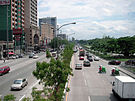
Quezon City
1 Quezon City Metro Manila 2,679,450 11 Dasmariñas CALABARZON 556,330 
Caloocan
2 Manila Metro Manila 1,660,714 12 Cagayan de Oro Northern Mindanao 553,966 3 Caloocan Metro Manila 1,378,856 13 Parañaque Metro Manila 552,660 4 Davao City Davao Region 1,363,337 14 Las Piñas Metro Manila 532,223 5 Cebu City Central Visayas 798,809 15 General Santos SOCCSKSARGEN 529,542 6 Zamboanga City Zamboanga Peninsula 774,407 16 Makati Metro Manila 510,383 7 Antipolo CALABARZON 633,971 17 Bacolod Western Visayas 499,497 8 Pasig Metro Manila 617,301 18 Muntinlupa Metro Manila 452,943 9 Taguig Metro Manila 613,343 19 Tagum Davao Region 450,526 10 Valenzuela Metro Manila 568,928 20 San Jose del Monte Central Luzon 439,090 Largest cities of Mindanao
Mindanao - Philippines 2007 CensusRank City Name Region Pop. Rank City Name Region Pop. 
Davao
1 Davao Davao Region 1,530,365 11 Marawi City ARMM 177,391 
Cagayan de Oro
2 Zamboanga Zamboanga Peninsula 774,407 12 Valencia City Northern Mindanao 162,745 3 Cagayan de Oro Northern Mindanao 553,966 13 Pagadian City Zamboanga Peninsula 161,312 4 General Santos SOCCSKSARGEN 529,542 14 Panabo City Davao Region 159,456 5 Tagum Davao Region 450,526 15 Malaybalay City Northern Mindanao 144,651 6 Iligan Northern Mindanao 318,040 16 Dipolog City Zamboanga Peninsula 141,027 7 Butuan Caraga Region 298,378 17 Surigao City Caraga Region 132,151 8 Cotabato City ARMM 259,153 18 Ozamiz City Northern Mindanao 123,137 9 Digos Davao Region 199,832 19 Gingoog City Northern Mindanao 111,787 10 Koronadal SOCCSKSARGEN 184,573 20 Bislig City Caraga Region 110,009 External links
- Official government website of the City of Zamboanga
- Zamboanga.com - Zamboanga City's original Web Portal
- City of Flowers
- Zamboanga Today Daily Newspaper
- Zamboanga Times Daily Newspaper
- Hola Zamboanga
- Na Mi Pueblo
- Mindanao Examiner Newspaper - Television
- Zamboanga Peninsula News
- Zamboanga Live Blog *Fiesta Pilar 2010*
Categories:- States and territories established in 1903
- States and territories disestablished in 1914
- Zamboanga City
- Cities in the Philippines
- Capitals of former nations
- Populated places established in 1635
- Populated coastal places in the Philippines
Wikimedia Foundation. 2010.


